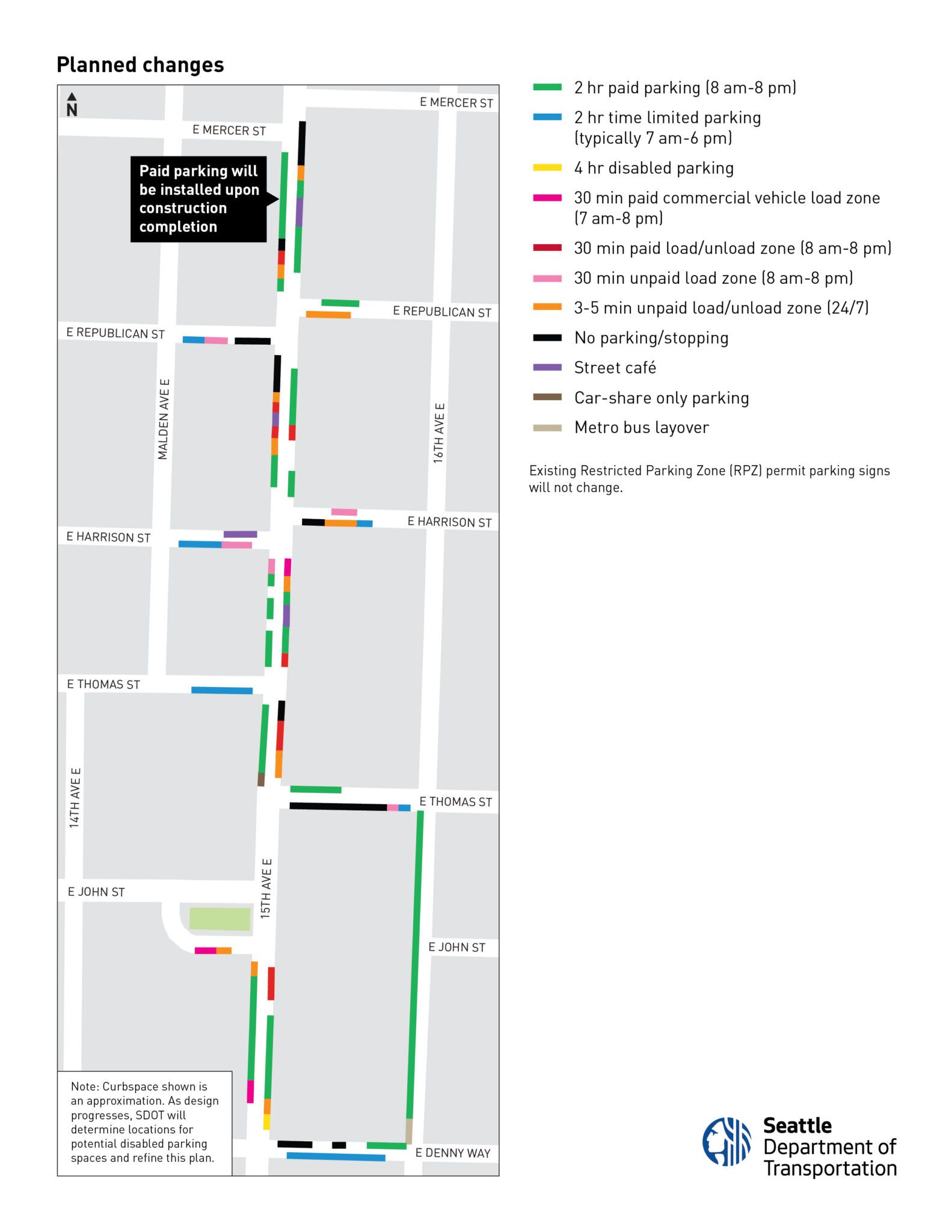 A view of 15th Ave E facing north from E Thomas St. Credit: SDOT
A view of 15th Ave E facing north from E Thomas St. Credit: SDOT Blog Stats: 750 words | 4-minute read
On Tuesday, October 10th, we’ll begin installing 2-hour paid parking on and around 15th Ave E from E Denny Way to E Mercer St, as well as on the west side of 16th Ave E from E Denny Way to E Thomas St.
There have been many recent changes in the neighborhood along 15th Ave E, including new street cafes and multiple planned developments, which have brought more visitors and residents to the area. This has made parking more difficult especially for neighborhood visitors and business customers. These changes will help us manage on-street parking, loading, and access more proactively as this neighborhood continues to grow.
Parking rates on 15th Ave E will reflect paid parking rates in other parts of Capitol Hill, including Broadway, Pike-Pine, and 12th Ave. The initial rates for 15th Ave E will be:
- Morning (8 am – 11 am): $0.50 per hour
- Afternoon (11 am – 5 pm): $2 per hour
- Evening (5 pm – 8 pm): $2 per hour
Paid parking will be in effect Monday – Saturday, 8 am to 8 pm. Parking will be free on Sundays and when time limits do not apply. Areas with existing 2-hour parking 8 am to 6 pm except by Residential Zone 4 Parking permit will not change as part of this project.
In addition to paid parking, we will also install new load zones and disabled parking on and around 15th Ave E to provide more reliable access at the curb for those uses.

In dense, mixed-use commercial areas like 15th Ave E, we prioritize short-term, on-street parking and loading over longer-term vehicle storage. Customers, commercial delivery drivers, and the growing area population all need reliable access to businesses along 15th Ave E.
Adding paid parking along 15th Ave E will improve customer access to businesses by increasing parking turnover and providing more reliable access at the curb. It will also reduce the number of vehicles circling to look for parking, which can increase emissions and the number of vehicles parked illegally, too close to driveways and crosswalks.

How did we decide to make these changes?
We use data to help us decide where parking changes are needed and what paid parking rates will be. In January 2023, we completed a parking study through our Community Access and Parking Program to evaluate parking conditions and demand on 15th Ave E.
This study found that on-street parking is very full, with an average of 90% of parking spaces filled most of the day, and more than 100% full in the afternoons. This means visitors and customers to the neighborhood often can’t find a space. Additionally, 16% of parking spaces were occupied by vehicles parked for more than 2 hours and 9% were occupied by a single vehicle parked for more than 3 hours. Even though this is a small percentage of vehicles, it has a big impact on parking availability throughout the day.
These study results show us that the existing 1-hour and 2-hour on-street parking time limits are no longer enough to manage on-street parking demand and access in the neighborhood around 15th Ave E.
To develop a plan for on-street changes to address these parking and access issues, we used feedback from a survey we conducted as well as door-to-door outreach with businesses to learn more about parking and loading needs. We heard that customers, commercial delivery drivers, and the growing population of the neighborhood all need more reliable access to on-street parking and load zones. We also heard that load zones are often used by parked vehicles and that more load zones are needed for goods and passengers.
Converting unpaid time limits to paid parking is how we manage parking across the city in high-demand areas. Paid parking is our most effective tool for creating reliable, short-term parking in areas with a lot of parking demand.
To learn more about this project, visit our webpage or check out our FAQs.
What to Expect
Crews will begin installing parking kiosks, signs, and paint on Tuesday, October 10th. Work is likely to last several days. Paid parking stations will begin accepting payment once installed and payment will be required.
Paid parking will apply Monday through Saturday, 8 am to 8 pm. Parking will be free on Sundays and when time limits do not apply.
Thank you for your interest in this project! If you have questions, please contact virginie.nadimi@seattle.gov.